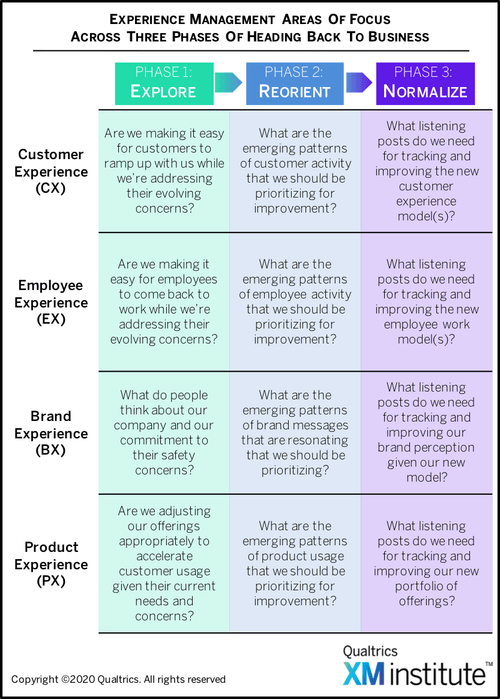I’ve studied human behavior for decades, examining how people respond to their environment as customers, employees, and leaders. Humans are amazingly resilient—for the good and bad. Even after facing disruptive events such as an epidemic or a recession, people tend to revert to their old ways shortly after the shock dissipates. People will go back to congregating, shaking hands, shopping at malls, and going without washing their hands more quickly than we’d think at the moment. Behavioral norms are hard to break.
That does not mean that the future will look exactly like the past. The evolution to a new normal will be a tug of war between people’s heightened anxiety about staying safe and their desire to return to highly engrained normative patterns of behavior.
Some Changes Will Persist Beyond the Crisis
While people don’t tend to change, there are some emergent behaviors that appear to have the momentum to stay longer. For an activity to continue, it needs to be economically favorable, fulfill an unmet human need that persists beyond the crisis, and nurtured into an evolved form as the crisis subsides. The ones that jump out to me as candidates for ongoing change are:
- Group video interactivity. Although people will not remain separated, the use of group video events will continue. People will go online for family gatherings, global training, college courses, and group workouts. This pandemic has accelerated the hurdle of trying and adopting these activities, and they fill a latent need for connection that exists beyond the replacement of in-person interactions.
- Blended delivery models. Now that a large portion of the older population has been pushed to order groceries, necessities, or meals online and either have them delivered or picked up from their local market, they’ll likely keep doing it—at least in some ways. I expect the use of blended models will become a standard component of everyday life, especially for older consumers.
- Streaming media consumption. People have turned to content services like Netflix, Disney+, and YouTube to fill their days. While the volume of binging will subside, these behaviors will likely continue to replace other media options. This shift, however, may decelerate if these services don’t actively keep first-time users engaged with appropriate pricing models and content.
- Work from home. Not all of the current home workers will continue spending workdays in their makeshift offices. But some will. And the need for organizations to enforce social distancing will push these activities for a longer time than many other temporary behaviors. Now that leaders and employees have been exposed to the benefits of working from home (and recognized where there are limitations), we’ll see more job descriptions allowing people to at least partially work remotely.
- Omnichannel medical care. Gaining access to healthcare services through channels beyond visiting a medical office or hospital had to become a mainstream activity at some point. It has all of the right advantages of a persistent norm, it’s better economically, while also being more convenient. The only thing that will hold this back is slow-to-move government regulations.
Three Phases of Returning to (New) Normal
As the world returns to some semblance of normal, changes will represent ongoing trade-offs between safety-oriented behaviors and the desire to return to old ways. Given this behavioral struggle, I suggest that organizations plan for three phases as they head back to business:
- Phase 1: Explore: People will quickly start doing some of the things they haven’t been able to do. The activities they do and the way they do them will be the result of balance between ongoing anxiety and the desire to get back to “normal.” This will be a somewhat chaotic period, where organizations need to be observant and responsive, and make sure they meet the rapidly changing desires and attitudes. They need to try new operating models, and refine them as they learn; all while providing evidence of their commitment to safety.
- Phase 2: Reorient: During this next phase, customers and employees will start to settle into patterns of behavior that will stick beyond the crisis period. In this stage, organizations need to aggressively reposition their existing offerings and messaging, and create future-looking operating norms. There will need to be a lot of alignment, as this change will affect suppliers, employees, partners, and customers.
- Phase 3: Normalize: After the new patterns emerge, organizations need to lock into operating models that support the new norms. During this period, organizations will likely formalize new offerings, look at the market through new customer segmentation models, develop supporting processes and systems, and go to market with a refined ecosystem of suppliers and partners.
The picture below provides a good metaphor for these phases. Before designing the landscape for Lafayette College’s quad, architects observed how students used the space. Once they saw patterns emerge by the beaten down grass that formed pathways, they built the asymmetric walkways that exist today. You’ll need to let people walk in phase 1, identify the patterns they take in phase 2, and then pave the paths in phase 3.

Tap into XM Along the Way
As I’ve discussed in the past, Experience Management (XM) is a critical capability during times of change. That’s because XM is all about staying connected with people (customers, employees, partners, and suppliers) by continuously learning (how they are thinking and feeling), propagating insights (to the right people in the right form at the right time), and rapidly adapting (to an increasing flow of actionable insights). In these fluid times, XM provides the human-connected adaptability required for organizations to successfully navigate their way back to business.
As you can see in the chart below, organizations will need a different approach to their XM efforts across the three phases in returning to the (new) normal: Explore, Reorient, and Normalize.

As your organization begins its journey towards normalization, here are some things to keep in mind:
- Chart your back to business phases. The three phases will occur in different ways and at different times across industries and markets. The way that people interact with the airline industry in the U.S. will normalize at a different rate and in a different manner than they do with retailers in the UK. Every organization needs to make its own unique plans for the three phases.
- Practice intentional patience. The early stages are primarily about trial, error, and learning. Even if something seems to work in the Explore stage, the success of that approach may not be persistent as people’s needs and priorities change. You need to maintain very quick cycles of sensing and adapting early on, while holding back on locking into a long-term direction until persistent patterns emerge.
- Capitalize on persistent changes. One of the most dramatic opportunities to disrupt your competitive environment is to tap into new behaviors and attitudes that persist beyond the crisis. The list above provides some areas for innovation, but there will likely be others as well. Make sure that you are tracking attitudes and behaviors of your customers and employees, and not just attempting to return to “the good old days.”
- Tap into engaged employees. Navigating through these back to business phases are much less about a great strategic plan, then they are about tapping into the insights and energy of your employees. Especially in the early stages, employees are your eyes and ears about what’s working and what needs to be changed. If you don’t keep your workers engaged, then they’ll never make the changes that you need at a pace that’s required in the market.
- Keep XM action-oriented. Late last year I labeled 2020 as “The Year of Insightful Actions.” Even before the pandemic, it was clear that organizations were most successful when their XM efforts focused on driving improvements and making better decisions. That’s the direction that many organizations have been forced into during the last few months. Don’t fall back into the pattern of using XM primarily as a source of metrics. Leaders should continue to ask the two ultimate questions: “What have you learned?” and “What improvements are you making?“
John F. Kennedy once noted that, “The Chinese use two brush strokes to write the word ‘crisis.’ One brush stroke stands for danger; the other for opportunity.” During this path to a new normal, don’t just aim to recover. If you come out of these three phases doing exactly what you were doing before, then you will likely fall behind. You need to identify how you will emerge with improved capabilities and enhanced offerings.
The bottom line: Stay focused on people as you head back to business.





